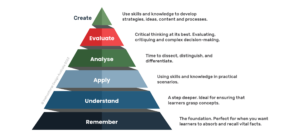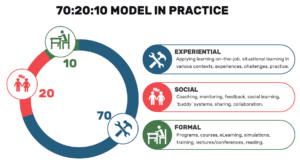Ebbinghaus’ Forgetting Curve
FREE download
Complete the form to download a quick reference guide (QRG) for creating effective learning programs using Ebbinghaus’ Forgetting Curve.
Ebbinghaus’ forgetting curve – a practical, everyday guide to making your learning programs as sticky as they can be. Let’s demystify this concept and explore how it can transform your approach to instructional design.
Decoding Ebbinghaus’ Forgetting Curve
Imagine learning something new and, within no time, it starts slipping away – sounds familiar, right? This is exactly what Hermann Ebbinghaus articulated through his forgetting curve. It shows that without effective reinforcement, memory of new information declines rapidly over time. However, this isn’t just a challenge; it’s an opportunity for instructional designers to make a real impact.
Why Ebbinghaus’ Forgetting Curve Matters in Instructional Design
In instructional design, our primary aim is to not only deliver information but ensure it’s retained and applied. Grasping the nuances of Ebbinghaus’ curve allows us to create learning experiences that are enduring and more impactful. It’s about crafting programs that are memorable, not just in the short term but for the long haul.
Practical Strategies for Long-lasting Learning

Spaced repetition
Revisit key concepts periodically. It’s like giving the brain gentle nudges to remember what’s important.
Schedule follow-up sessions post-training to reinforce key points, ensuring a lasting impact.

Active recall
Incorporate quizzes and flashcards, compelling learners to actively retrieve information.
Foster group discussions where employees can recap and reinforce what they’ve learned.

Interleaving techniques
Integrate different but related topics, encouraging deeper understanding and connection-making.
Alternate between varied concepts in a single course to enhance cognitive engagement.

Application in real life contexts
Incorporate projects or tasks that mirror real-life scenarios, thereby anchoring theoretical knowledge in practical experience.
Use role-play or case studies to simulate realistic situations, enhancing the applicability of the skills learned.

Use visual aids and mnemonics
Use visual tools like infographics or mind maps for complex subjects, aiding in the visualisation and recall of information.
Create memorable mnemonics or slogans to help embed critical safety information in the learner’s long-term memory.

Feedback and correction
Peer feedback for collaborative learning and correction.
Provide quick-reference tools for continual learning and application on the job.
Ebbinghaus’ forgetting curve is not just a psychological concept; it’s a vital tool in the arsenal of any instructional designer. By implementing strategies like spaced repetition, active recall, and real-life application, we’re not just fighting forgetfulness; we’re crafting learning experiences that resonate and endure. Our goal is to turn those fleeting moments of learning into lasting pillars of knowledge and skill. With Ebbinghaus’ insights, we can create educational journeys that are not just memorable but also profoundly effective. Let’s embrace these strategies and transform how we approach learning design.
Related articles



Bloom’s Taxonomy: A Guide for Creating Effective Learning Outcomes
Merrill’s Instructional Design Principles
The 70:20:10 Learning Model
